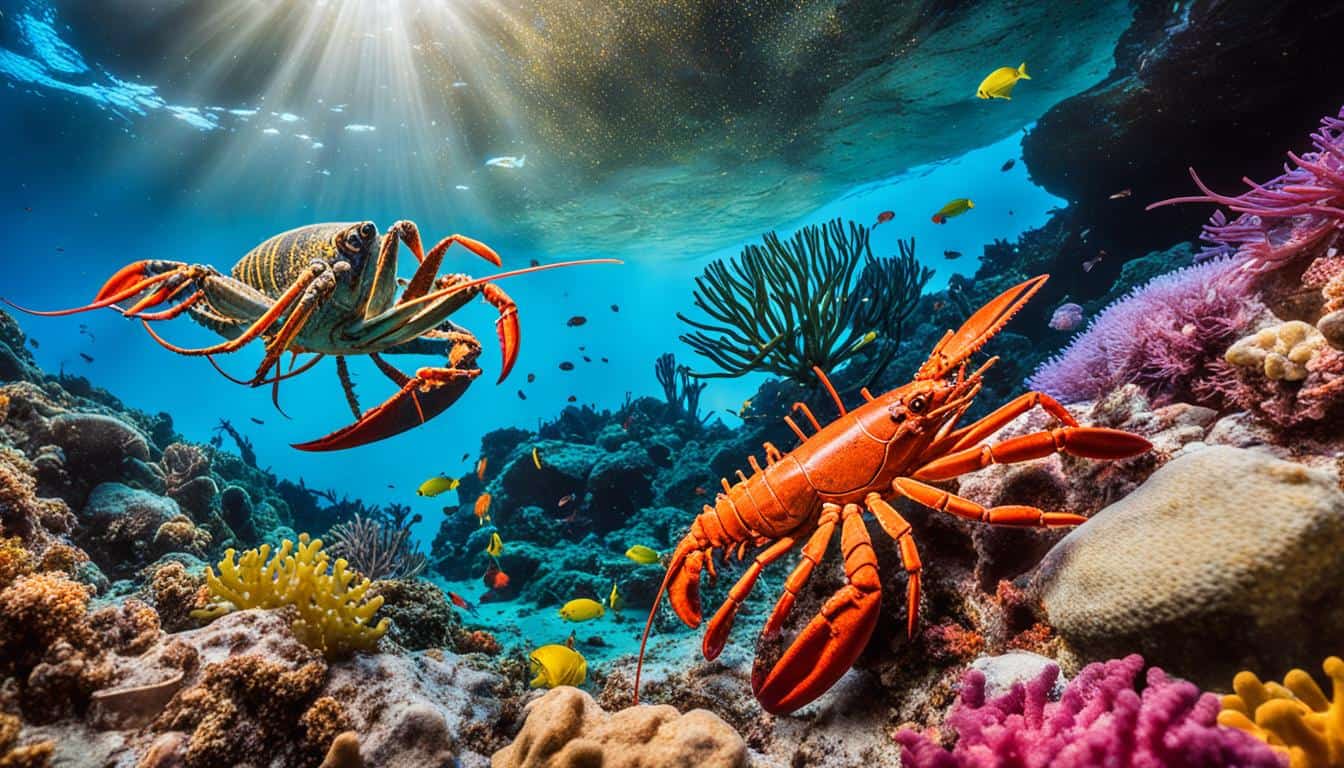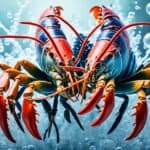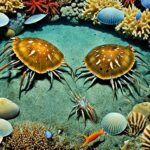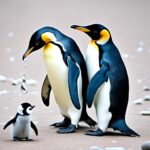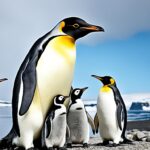Lobsters play a big role in the ocean’s balance. They live in the Atlantic Ocean and are important as both hunters and prey. By looking into how lobsters interact with other sea creatures, we see how they keep the ocean’s life diverse.
Lobsters keep algae in check, which helps manage the growth of crabs and sea urchins. They also feed larger sea creatures, which is key to the ocean’s food web. This complex network of relationships helps keep coral reefs and other ocean areas stable.
The Ecological Role of Lobsters in Marine Ecosystems
Lobsters are key to keeping marine ecosystems healthy and balanced. They affect many parts of life under the sea, from controlling algae to shaping food chains. Learning about lobsters shows us how they help the ocean.
Algae Control
Lobsters help keep algae in check in their homes. By eating algae, they stop it from taking over, which could harm coral reefs. This helps corals stay healthy and keeps the reef life vibrant.
Managing algae well lets corals get the sunlight and nutrients they need to grow.
Food Chain Dynamics
Lobsters play a big part in the food chain. They eat and are eaten by other sea creatures, keeping populations in check. This balance keeps ecosystems diverse and stable.
Big predators depend on lobsters for food, making them crucial to the food web.
Habitat Engineering
Lobsters also change their homes in ways that help other sea life. Some lobsters dig burrows that become homes for many other creatures. These changes increase the variety of life in the area.
Through their actions, lobsters make habitats that are more stable and resilient.
How do lobsters interact with other marine life?
Lobsters are key players in coral reef ecosystems. They interact with many other sea creatures. These interactions show how vital lobsters are in these complex environments.
Lobsters and Their Relationships with Coral Reefs
Lobsters and coral reefs have a crucial connection. They help keep the ecosystem healthy. By eating algae, lobsters stop it from harming the corals.
Algae can take over and harm coral growth. But lobsters eat it, helping corals to thrive. This keeps the reef’s biodiversity high.
Lobsters also dig burrows in the sand. These burrows are homes for smaller sea creatures. They help create a safe place for many marine animals.
The Caribbean spiny lobster eats algae and shelters small fish and invertebrates. These actions make coral reefs stronger. Lobsters help make reefs more lively and sustainable.

| Interaction Type | Description | Impact on Ecosystem |
|---|---|---|
| Grazing | Lobsters consume excess algae | Promotes coral growth |
| Burrowing | Creates shelter for small organisms | Enhances biodiversity |
| Energy Transfer | Facilitates nutrient recycling | Maintains ecological balance |
Lobster Behavior with Other Sea Creatures
Lobsters play a big part in how they interact with other sea creatures. In the ocean, they show unique social behaviors. These behaviors shape their relationships with other marine animals. It helps us understand the complex web of life under the sea.
Social Behavior of Lobsters in the Ocean
Lobsters have complex social lives. They show territoriality, which is key for finding mates and getting food. This means they:
- Set up dominance hierarchies among themselves.
- Compete for the best hiding spots and food.
- Use body language and chemical signals to communicate.
This helps them adapt to different places. By defending their territory, lobsters make sure they can survive. This affects the balance of their home in the ocean.
Mutual Interactions of Lobsters with Sea Life
Lobsters have interesting partnerships with other sea creatures. For example, they live with conchs and small fish. Each one gets something good from the deal:
| Sea Creature | Mutual Benefit |
|---|---|
| Conchs | Clear the seafloor and get protection from predators. |
| Small Fish | Take shelter in lobster burrows and clean them. |
| Crustaceans | Work together to keep the reef healthy. |
This teamwork helps control algae growth. It makes a place where lobsters and other sea animals can do well. These partnerships show how important lobsters are to their ocean homes.
Impact of Lobsters on Food Chain Dynamics
Lobsters are key to keeping marine ecosystems balanced. They act as both hunters and hunted in the ocean’s food chain. By controlling the numbers of other species, they prevent overpopulation and keep the ecosystem stable.
This makes lobsters essential to the food chain. They keep other sea creatures in check, ensuring a balanced environment.
Habitat Engineering by Lobsters
The Caribbean spiny lobster shows how lobsters improve their homes and help others. They dig deep burrows that become safe spots for many sea creatures. These burrows help create complex ecosystems that can withstand changes in the environment.
When lobsters become food for bigger sea animals, they also help move nutrients through the food web. This shows how lobsters affect marine life in many ways.
Understanding the lobster’s role in the food chain shows their importance beyond just being eaten. They shape the environment, affecting many other species. The relationship between lobsters and other sea life highlights the value of every creature in ocean ecosystems.
FAQ
How do lobsters interact with other marine life?
Lobsters play a big role in the ocean by eating and being eaten. They help keep the balance of species and help other creatures survive. They work together with other sea animals, making life better for everyone.
What ecological role do lobsters play in marine ecosystems?
Lobsters are key to ocean health. They eat algae, which stops it from taking over. They also help by making homes for other sea creatures with their burrows.
How do lobsters influence coral reef ecosystems?
Lobsters help coral reefs by eating algae. This stops the algae from harming the corals. Their homes also give shelter to small fish and other sea animals, keeping the reef strong.
What is the social behavior of lobsters in the ocean?
Lobsters live in groups and have leaders. These groups help them find food and mates. This way of living affects how they interact with other sea creatures.
What type of mutual interactions do lobsters have with other sea creatures?
Lobsters work together with conchs and small fish. These partnerships help both sides. Small fish hide in lobster homes and help keep the reef healthy.
How do lobsters impact food chain dynamics?
Lobsters play a big part in the food chain. They keep the number of smaller animals in check. They are eaten by bigger animals and also eat smaller ones, keeping the balance right.
What is habitat engineering by lobsters?
Lobsters make homes in the ocean floor. These homes help many other sea animals by giving them a safe place to live. This makes the ocean more stable for everyone.

